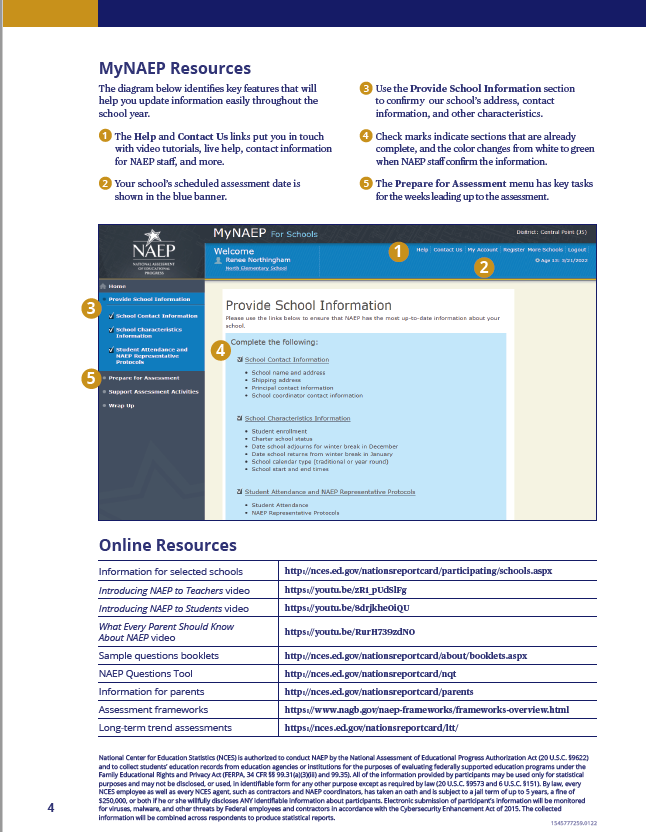NAEP 2022 Appendix D4
NAEP 2022 Appendix D4.docx
National Assessment of Educational Progress (NAEP) 2022 Materials Update #3
NAEP 2022 Appendix D4
OMB: 1850-0928
National Center for Education Statistics
National Assessment of Educational Progress
National Assessment of Education Progress (NAEP)
Long-Term Trend (LTT Age 13) 2022
Materials #3
Appendix D4
Long Term Trend (LTT) 2022 Communications and Recruitment Materials
OMB# 1850-0928 v.26
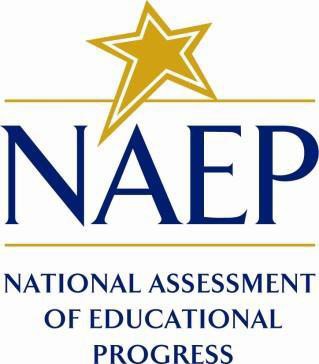
February 2022
Table of Contents
Appendix D4-3: Assessment Details Letter National State Coordinator to School Coordinator, LTT 9
Appendix D4-4: NAEP 2022 CSSO to District Superintendent 12
Appendix D4-5: NAEP 2022 Facts for Districts 14
Appendix D4-6: NAEP 2022 Facts for Teachers- Public and Private 19
Appendix D4-7: NAEP 2022 Save the Date 25
Appendix D4-8: NAEP 2022 Parent/Guardian Notification Public Schools- English and Spanish 27
Appendix D4-9: NAEP 2022 Parent/Guardian Notification Private Schools- English and Spanish 31
Appendix D4-12: NAEP 2022 NAEP in Your School, LTT, Public Schools and Private Schools 46
Appendix D4-13: NAEP 2022 LTT Age 13 Sample Endorsement Letters 54
Appendix D4-14: NAEP 2022 LTT Age 13 MyNAEP Registration Instructions for Schools 58
Appendix D4-1: NAEP 2022 Initial Notification Letters from NAEP State Coordinator to School Principal, LTT
NAEP Fall 2022 Initial Notification Letter From
NAEP STATE COORDINATOR TO SCHOOL PRINCIPAL: For LTT Age 13
Red text should be customized before mail merge; highlighted text represents mail merge fields
Dear Principal,
Thank you for all that you do to support education in state name. I am writing to inform you that school name has been selected to represent schools across the nation by participating in the 2022 administration of the National Assessment of Educational Progress (NAEP). NAEP is the largest nationally representative and continuing assessment of what students in the United States know and can do in various subjects. It is administered by the National Center for Education Statistics (NCES), within the U.S. Department of Education. As part of the NAEP 2022 program, students will participate in mathematics and reading long-term trend assessments. Results will be released as The Nation’s Report Card.
Thirteen-year-old
students will participate in long-term trend mathematics and reading
assessments.
Each student will be assessed in one subject only.
The long-term trend data collected can be linked to NAEP assessments
conducted in the early 1970s to measure progress over time. For now,
I am writing only to notify you of the assessment. In June, I will
send you an assessment date. If the date presents a conflict for your
school, we will work together to identify an alternate. Our goal is
to schedule the assessment prior to the beginning of the school year
so that you may include the assessment date on your 2022–2023
school calendar. As the
COVID-19 pandemic continues, NAEP will continue to adapt to new
processes and procedures. For more information about updated NAEP
administration plans, please visit our web page at
https://nces.ed.gov/nationsreportcard/about/covid19.aspx
and see the enclosed document, NAEP
COVID-19 Protocols.
At the beginning of the school year, I will send you detailed assessment information and will ask you to identify a school coordinator, provide a student list, and submit additional information. NAEP representatives will provide significant support to your school by administering the assessment and bringing all materials and equipment. The following is a broad overview of the assessment details:
Subjects: Mathematics and reading
Students to be assessed: 13-year-olds
Assessment window: October 10–December 16, 2022
Assessment duration: Approximately 90 minutes (including transition time,
instructions, and completion of survey questions)
Assessment administrator: NAEP representatives
Information about NAEP can be found in the enclosures listed below and at http://nces.ed.gov/nationsreportcard/ltt/. If you have questions, please contact me at telephone number or via email at email address.
Our chief state school officer, name, and your district superintendent, name, support NAEP and look forward to your school’s participation. We know that we can count on you to help reach our goal of 100 percent participation.
Sincerely,
NAEP State Coordinator
Enclosures: NAEP COVID-19 Protocols
CC: District Test Director
National Center for Education Statistics (NCES) conducts the National Assessment of Educational Progress to evaluate federally supported education programs. All of the information you provide may be used only for statistical purposes and may not be disclosed, or used, in identifiable form for any other purpose except as required by law (20 U.S.C. §9573 and 6 U.S.C. §151). By law, every NCES employee as well as every NCES agent, such as contractors and NAEP coordinators, has taken an oath and is subject to a jail term of up to 5 years, a fine of $250,000, or both if he or she willfully discloses ANY identifiable information about you. Electronic submission of your information will be monitored for viruses, malware, and other threats by Federal employees and contractors in accordance with the Cybersecurity Enhancement Act of 2015.
Appendix D4-2: NAEP 2022 Final Notification Letters from NAEP State Coordinator to School Coordinator, LTT
NAEP Fall 2022 Assessment Details Letter
NAEP STATE COORDINATOR TO SCHOOL COORDINATOR
Red text should be customized before mail merge, highlighted text represents mail merge fields.
Dear School Coordinator:
Welcome to the 2022 National Assessment of Educational Progress (NAEP). I look forward to working with you to coordinate NAEP at school name. A sample of 13-year-old students will take mathematics and reading assessments on assessment date. Each student will take only one assessment.
As the school coordinator, you will have a number of responsibilities critical to making NAEP a success. The MyNAEP website is designed to assist you with these responsibilities. The timeline below indicates when you will need to complete specific MyNAEP sections.
August–September: Register at www.mynaep.com with the following registration ID: MyNAEP Registration ID. Answer the questions in the Provide School Information section by date.
For instructions, see the enclosed School Coordinator Responsibilities: A Guide to MyNAEP.The following red text should only be included for schools that are submitting their own student lists. September: Prepare and submit a list of all 13-year-old students electronically in the Submit Student List section by <insert date>. Please see the enclosed Student List Submission Instructions.
September–October: An assigned NAEP representative who is responsible for administering the assessment will contact you. At that time, you will log on to the MyNAEP site with the representative and discuss how to complete the Prepare for Assessment section. Major tasks are highlighted below.
Provide information about students with disabilities and English learners (SD/EL) so that assessment administrators can plan appropriate testing accommodations. You can request MyNAEP access for your school’s SD/EL specialists on the Complete SD/EL Student Information page so that they can assist with this task.
Notify parents/guardians that their children have been selected for the assessment. A sample parent/guardian notification letter is enclosed and will be available on the MyNAEP website for you to customize and print on your school letterhead.
Schedule assessment sessions and reserve space at your school.
Participate in a preassessment review call with your assigned NAEP representative.
During this call, you will review and confirm information entered into MyNAEP and other assessment details. Be sure to complete all Prepare for Assessment activities before the scheduled call.
One week before the assessment: Visit the Support Assessment Activities section to print student appointment cards and notify teachers in advance so they know when to release students from class.
After the assessment: Safeguard all confidential hardcopy materials until the date noted on the NAEP Storage Envelope. Shred all materials on the specified date.
During the assessment, we would appreciate the presence of a school staff person as an observer in each session. A staff member’s presence can have a positive impact on students’ motivation and performance.
More information about your responsibilities is provided in the enclosed brochure School Coordinator Responsibilities: A Guide to MyNAEP. Additional information about NAEP can be found at http://nces.ed.gov/nationsreportcard.
Thank you in advance for your cooperation and effort in helping to coordinate this important assessment. If you have any questions, please feel free to contact me at telephone number or email address.
Sincerely,
NAEP State Coordinator
Enclosures: NAEP folder, including the following:
School Coordinator Responsibilities: A Guide to MyNAEP
Student List Submission Instructions
Parent/Guardian Notification Letter
MyNAEP Registration Instructions
National Center for Education Statistics (NCES) conducts the National Assessment of Educational Progress to evaluate federally supported education programs. All of the information you provide may be used only for statistical purposes and may not be disclosed, or used, in identifiable form for any other purpose except as required by law (20 U.S.C. §9573 and 6 U.S.C. §151). By law, every NCES employee as well as every NCES agent, such as contractors and NAEP coordinators, has taken an oath and is subject to a jail term of up to 5 years, a fine of $250,000, or both if he or she willfully discloses ANY identifiable information about you. Electronic submission of your information will be monitored for viruses, malware, and other threats by Federal employees and contractors in accordance with the Cybersecurity Enhancement Act of 2015.
Appendix D4-3: Assessment Details Letter National State Coordinator to School Coordinator, LTT
NAEP Fall 2022 Assessment Details Letter
NAEP STATE COORDINATOR TO SCHOOL COORDINATOR
Red text should be customized before mail merge, highlighted text represents mail merge fields.
Dear School Coordinator:
Welcome to the 2022 National Assessment of Educational Progress (NAEP). I look forward to working with you to coordinate NAEP at school name. A sample of 13-year-old students will take mathematics and reading assessments on assessment date. Each student will take only one assessment.
As the school coordinator, you will have a number of responsibilities critical to making NAEP a success. The MyNAEP website is designed to assist you with these responsibilities. The timeline below indicates when you will need to complete specific MyNAEP sections.
August–September: Register at www.mynaep.com with the following registration ID: MyNAEP Registration ID. Answer the questions in the Provide School Information section by date.
For instructions, see the enclosed School Coordinator Responsibilities: A Guide to MyNAEP.The following red text should only be included for schools that are submitting their own student lists. August/September: Prepare and submit a list of all 13-year-old students electronically in the Submit Student List section by <insert date>. Please see the enclosed Student List Submission Instructions.
September–October: An assigned NAEP representative who is responsible for administering the assessment will contact you. At that time, you will log on to the MyNAEP site with the representative and discuss how to complete the Prepare for Assessment section. Major tasks are highlighted below.
Provide information about students with disabilities and English learners (SD/EL) so that assessment administrators can plan appropriate testing accommodations. You can request MyNAEP access for your school’s SD/EL specialists on the Complete SD/EL Student Information page so that they can assist with this task.
Notify parents/guardians that their children have been selected for the assessment. A sample parent/guardian notification letter is enclosed and will be available on the MyNAEP website for you to customize and print on your school letterhead.
Schedule assessment sessions and reserve space at your school.
Participate in a preassessment review call with your assigned NAEP representative.
During this call, you will review and confirm information entered into MyNAEP and other assessment details. Be sure to complete all Prepare for Assessment activities before the scheduled call.
One week before the assessment: Visit the Support Assessment Activities section to print student appointment cards and notify teachers in advance so they know when to release students from class.
After the assessment: Safeguard all confidential hardcopy materials until the date noted on the NAEP Storage Envelope. Shred all materials on the specified date.
During the assessment, we would appreciate the presence of a school staff person as an observer in each session. A staff member’s presence can have a positive impact on students’ motivation and performance.
More information about your responsibilities is provided in the enclosed brochure School Coordinator Responsibilities: A Guide to MyNAEP. Additional information about NAEP can be found at http://nces.ed.gov/nationsreportcard.
Thank you in advance for your cooperation and effort in helping to coordinate this important assessment. If you have any questions, please feel free to contact me at telephone number or email address.
Sincerely,
NAEP State Coordinator
Enclosures: NAEP folder, including the following:
School Coordinator Responsibilities: A Guide to MyNAEP
Student List Submission Instructions
Parent/Guardian Notification Letter
MyNAEP Registration Instructions
National Center for Education Statistics (NCES) conducts the National Assessment of Educational Progress to evaluate federally supported education programs. All of the information you provide may be used only for statistical purposes and may not be disclosed, or used, in identifiable form for any other purpose except as required by law (20 U.S.C. §9573 and 6 U.S.C. §151). By law, every NCES employee as well as every NCES agent, such as contractors and NAEP coordinators, has taken an oath and is subject to a jail term of up to 5 years, a fine of $250,000, or both if he or she willfully discloses ANY identifiable information about you. Electronic submission of your information will be monitored for viruses, malware, and other threats by Federal employees and contractors in accordance with the Cybersecurity Enhancement Act of 2015.
Appendix D4-4: NAEP 2022 CSSO to District Superintendent
NAEP Fall 2022 Early-May Notification Letter From
CHIEF STATE SCHOOL OFFICER TO DISTRICT SUPERINTENDENT
Red text should be customized before mail merge: highlighted text represents mail merge fields
Dear District Superintendent name,
Thank you for all that you do to support education in state name. I am writing to notify you that number schools in your district have been selected to participate in the 2022 administration of the National Assessment of Educational Progress (NAEP). NAEP is the largest nationally representative and continuing assessment of what students in the United States know and can do in various subjects. It is administered by the National Center for Education Statistics (NCES), within the U.S. Department of Education. Selected schools represent schools across the nation, and their participation provides an accurate picture of student performance. School District will play an important role by participating, and I hope that we can count on your full support to make this a positive experience for your schools and students.
In fall 2022, NAEP will administer long-term trend assessments in mathematics and reading to 13-year-old students. Please refer to the attached list of schools in your district selected for NAEP long-term trend. Selected schools are notified in advance so that principals can place the assessment windows on their calendars and incorporate NAEP into the planned school program. A few additional schools within School District may also be selected at a later date; your NAEP State Coordinator will contact you should this happen. Starting in June, each school will receive its assessment date. Schools may work with the NAEP State Coordinator if there is a conflict with the scheduled date.
The data collected from long-term trend can be linked to NAEP assessments conducted since the early 1970s to measure progress over time. National-level results will be released as The Nation’s Report Card.
As in previous years, NAEP representatives provide significant support to schools by administering the assessment and bringing all necessary materials and equipment. NAEP representatives’ top priority is to protect the health and safety of students and school staff. For more information about updated NAEP administration plans and COVID-19 protocols, please visit our web page at https://nces.ed.gov/nationsreportcard/about/covid19.aspx and see the enclosed document.
Please include the NAEP assessment window (October 10–December 16, 2022) on your district test calendar. Information about NAEP can be found in the enclosures listed below and at http://nces.ed.gov/nationsreportcard. Name, our NAEP State Coordinator, will contact your staff with additional information.
Thank you for supporting this important assessment and for helping accomplish our goal of 100 percent participation.
Sincerely,
Name of Chief State School Officer
Enclosures: District List of Schools Selected for NAEP
Facts
for Districts
NAEP
COVID-19 Protocols
CC: State Testing Director
District Testing Director
NAEP State Coordinator
National Center for Education Statistics (NCES) conducts the National Assessment of Educational Progress to evaluate federally supported education programs. All of the information you provide may be used only for statistical purposes and may not be disclosed, or used, in identifiable form for any other purpose except as required by law (20 U.S.C. §9573 and 6 U.S.C. §151). By law, every NCES employee as well as every NCES agent, such as contractors and NAEP coordinators, has taken an oath and is subject to a jail term of up to 5 years, a fine of $250,000, or both if he or she willfully discloses ANY identifiable information about you. Electronic submission of your information will be monitored for viruses, malware, and other threats by Federal employees and contractors in accordance with the Cybersecurity Enhancement Act of 2015.
Appendix D4-5: NAEP 2022 Facts for Districts
NAEP: Fall 2022
Facts for Districts
“NAEP is the only assessment providing half a century of performance data to measure what students know and can do. The state and national trends inform local, state, and national program and policy discussions that improve teaching and learning.”
—David Atherton, EdD, Principal, Clear Creek Middle School, Gresham, OR
What is NAEP?
The National Assessment of Educational Progress (NAEP) is an integral measure of academic progress across the nation and over time. It is the largest nationally representative and continuing assessment of what our nation’s students know and can do in various subjects such as civics, mathematics, reading, and U.S. history. The program also provides valuable insights into students’ educational experiences and opportunities to learn in and outside of the classroom.
NAEP is a congressionally mandated program administered by the National Center for Education Statistics (NCES), within the U.S. Department of Education and the Institute of Education Sciences.
How are NAEP results reported?
The results of NAEP are released as The Nation’s Report Card. Depending on the assessment, NAEP results are available for the nation, states, and select urban districts that participate in the Trial Urban District Assessment (TUDA). Results are also available for different student groups, based on factors such as race/ethnicity, gender, school location, and more. NAEP is not designed to collect or report results for individual students, classrooms, or schools.
Why should my district participate in NAEP?
Your district’s participation will help ensure that educators, policymakers, and elected officials have reliable data to better understand and improve student learning. Schools and students selected to participate in NAEP represent schools and students across the country. When students participate and give their best effort, NAEP results provide the most accurate and representative measure possible of student achievement and experience.
What NAEP assessments will be administered in fall 2022?
The NAEP long-term trend assessment will be administered via paper and pencil to 13-year-olds between October 10 and December 16, 2022. NAEP long-term trend assessments measure student performance in mathematics and reading, and allow the performance of today’s students to be compared with students since the early 1970s. Students will also be asked to complete a survey questionnaire to provide a better understanding of factors that may be related to students’ learning. There will be no teacher questionnaire, but a school questionnaire will be administered to gather information about school policies and characteristics, including during the COVID-19 pandemic.
Results will be released for the nation.
What will students in my district do?
Participating students will complete subject-area questions in mathematics or reading. Each student will be assessed in one subject only. Students will also complete a survey questionnaire that provides valuable information about their educational experiences and opportunities to learn both in and outside of the classroom, as well as how they have accessed learning during the COVID-19 pandemic.
It takes participating students approximately 90 minutes to complete the long-term trend assessment. This includes transition time, directions, and completion of survey questionnaires. A broad range of accommodations are provided for students with disabilities and English learners.
Do teachers need to prepare students for the assessment?
Teachers do not need to prepare their students to take the assessment but should encourage them to do their best.
How can school administrators and teachers use NAEP data to help our students?
The NAEP Data Explorer (nationsreportcard.gov/ndecore) is a powerful tool that allows you to examine the relationships between student performance and factors such as instructional practices, school resources, and more.
Questions from previous NAEP assessments can also be used as a helpful educational resource in the classroom. Teachers can use the NAEP Questions Tool (nces.ed.gov/nationsreportcard/nqt) to see how their students’ performance compares to peers in your state and across the nation. Released NAEP questions come with a scoring guide, sample student responses, and performance data.
Who will administer NAEP? What do schools need to provide on the day of the assessment?
NAEP representatives will administer the NAEP assessment and provide significant support to schools on assessment day. They will wear necessary personal protective equipment (PPE) and follow all school-specific health protocols. NAEP representatives will also bring all necessary materials and equipment. Schools will only need to provide space for students to take the assessment, including desks or tables.
How were schools in my district selected for NAEP?
Schools were selected as part of a carefully designed sampling process that ensures NAEP-selected schools and students are representative of your district, state, and the nation.
How is NAEP different from our state assessment?
NAEP serves a different role than state assessments. While states have their own unique assessments to measure student achievement against specific content standards, NAEP is designed to provide a common measure of student performance and progress across the country.
How long has NAEP been around?
NAEP was first administered in 1969 to measure student achievement nationally. In 1990, NAEP was administered at the state level for the first time. The NAEP TUDA program, which measures student achievement in some of the nation’s large urban districts, began in 2002. The program has come to be recognized as the gold standard of large-scale assessments due to its high technical quality and rigorous design and methodology.
How often is NAEP administered?
As part of main NAEP, students in grades 4 and 8 are scheduled to be assessed at the state and national levels in mathematics and reading every 2 years. Under the Elementary and Secondary Education Act, districts and states that receive Title I funds are required to participate in these biennial assessments. Other subjects are assessed periodically. Long-term trend assessments for 9-, 13-, and 17-year-olds are also assessed periodically.
Where can I find more information?
Learn more about the NAEP program at nces.ed.gov/nationsreportcard, and explore the latest NAEP results at nationsreportcard.gov.
Visit nces.ed.gov/nationsreportcard/about/covid19.aspx for more information about NAEP COVID-19 protocols.
You can also find NAEP on: <Facebook logo> <Twitter logo> <YouTube logo>
National Center for Education Statistics (NCES) conducts the National Assessment of Educational Progress to evaluate federally supported education programs. All of the information you provide may be used only for statistical purposes and may not be disclosed, or used, in identifiable form for any other purpose except as required by law (20 U.S.C. §9573 and 6 U.S.C. §151). By law, every NCES employee as well as every NCES agent, such as contractors and NAEP coordinators, has taken an oath and is subject to a jail term of up to 5 years, a fine of $250,000, or both if he or she willfully discloses ANY identifiable information about you. Electronic submission of your information will be monitored for viruses, malware, and other threats by Federal employees and contractors in accordance with the Cybersecurity Enhancement Act of 2015.
This publication was prepared for the National Assessment of Educational Progress by Hager Sharp under contract GS-23F-0024M to the National Center for Education Statistics, U.S. Department of Education.
Appendix D4-6: NAEP 2022 Facts for Teachers- Public and Private
NAEP Fall 2022 Facts for Teachers
What is NAEP?
The National Assessment of Educational Progress (NAEP) is an integral measure of academic progress over time. It is the largest nationally representative and continuing assessment of what our nation’s students know and can do in various subjects such as civics, mathematics, reading, science, technology and engineering literacy, U.S. history, and writing. The program also provides valuable insights into students’ educational experiences and opportunities to learn in and outside of the classroom. Elected officials, policymakers, and educators all use NAEP results to develop ways to improve education.
NAEP is a congressionally mandated program administered by the National Center for Education Statistics (NCES), within the U.S. Department of Education and the Institute of Education Sciences.
What NAEP assessments will be administered in fall 2022?
The NAEP long-term trend assessment will be administered via paper and pencil to 13-year-olds between October 10 and December 16, 2022. NAEP long-term trend assessments measure student performance in mathematics and reading, and allow the performance of today’s students to be compared with students since the early 1970s. Each student will be assessed in one subject only.
Students will also be asked to complete a survey questionnaire. They may answer as many questions as they like and skip any question by leaving a response blank. NAEP survey questionnaires provide valuable information about participating students’ educational experiences and opportunities to learn both in and outside of the classroom, as well as how they have accessed learning during the COVID-19 pandemic. There will be no teacher questionnaire, but a school questionnaire will be administered to gather information about school policies and characteristics, including during the COVID-19 pandemic.
Results
will be released for the nation. Learn more about the long-term trend
assessments at https://nces.ed.gov/nationsreportcard/ltt.
“As a teacher, my constant focus is to help students make progress in the classroom. NAEP helps with this mission by creating a common measure of student achievement across the country.”
— Iris Garcia, Teacher, Biscayne Elementary Community School, Miami Beach, Florida
What can teachers and students expect?
It takes approximately 90 minutes to complete the long-term trend assessment. This includes transition time, directions and tutorials, and completion of a survey questionnaire. A broad range of accommodations are provided for students with disabilities and English learners. Teachers do not need to prepare their students to take the assessment, but they should encourage students to do their best.
Who will administer NAEP? What do schools need to provide on the day of the assessment?
NAEP representatives will administer the NAEP assessment and provide significant support to schools on assessment day. They will wear necessary personal protective equipment (PPE) and follow all school-specific health protocols. NAEP representatives will also bring all necessary materials and equipment. Schools will only need to provide space for students to take the assessment, including desks or tables.
How are schools and students selected for NAEP?
Schools are selected as part of a carefully designed sampling process that ensures NAEP-selected schools and students are representative of all schools and students across the United States.
How is NAEP different from our state assessment?
NAEP serves a different role than state assessments. While states have their own unique assessments with different content standards, the same NAEP assessment is administered in every state, providing a common measure of student achievement.
NAEP and Teachers
How are teachers essential partners in NAEP?
Schools and students selected to participate in NAEP represent schools and students across the country. Teachers make an important contribution by encouraging their students to participate and to give their best effort; this helps ensure that NAEP results provide the most accurate measure possible of student achievement across the country. To learn more about NAEP and view FAQs for teachers, visit https://nces.ed.gov/nationsreportcard/educators/.
Why are students, teachers, and principals asked to complete survey questionnaires?
In addition to subject-area questions, students participating in NAEP are asked to complete a survey questionnaire. Results from the questionnaire help put student achievement results into context, allow for meaningful comparison between student groups, and offer important insights for educators, policymakers, and researchers to better understand students’ educational experiences in the United States.
Teachers of students participating in NAEP are also asked to complete a survey questionnaire. The NAEP teacher survey questionnaire gathers information on teacher training and instructional practices. The questionnaire will be delivered via an online format, but teachers can request a paper-and-pencil version. There is no teacher questionnaire for the long-term trend assessment.
Principals or school administrators of students participating in NAEP are asked to complete a survey questionnaire that provides information about school policies and characteristics. The questionnaire will also be delivered via an online format, but a paper-and-pencil version is available upon request.
To learn more about NAEP survey questionnaires and view student, teacher, and school questionnaires from previous years, visit https://nces.ed.gov/nationsreportcard/survey_questionnaires.aspx.
How can teachers use NAEP resources and data to help students?
You can use the NAEP Questions Tool (https://nces.ed. gov/nationsreportcard/nqt) to view released NAEP items and create customized assessments for your classroom. You can compare your students’ performance with their peers in your state and across the nation. Teachers, students, and parents can access information and also compare results for various demographic groups. Most released items include a scoring guide, sample student responses, and performance data.
The NAEP Data Explorer (https://www.nationsreportcard.gov/ndecore) is a powerful tool that allows you to examine the relationships between student performance and factors like instructional practices, school resources, and more.
How do the NAEP online dashboards help teachers explore NAEP results and more?
The Achievement Gaps Dashboard lets users explore achievement gaps that reveal significant differences in assessment scores between two groups of students (e.g., male and female students or White and Black students). You can also examine the latest national results in all the NAEP subjects and students’ educational experiences by school type with the new Public, Private, and Charter Schools Dashboard.
View the Achievement Gaps Dashboard at https://www.nationsreportcard.gov/dashboards/achievement_gaps.aspx.
The Public, Private, and Charter Schools Dashboard is available at https://www.nationsreportcard.gov/dashboards/schools_dashboard.aspx.
The Monthly School Survey Dashboard (https://ies.ed.gov/schoolsurvey/) offers a monthly snapshot of learning opportunities (i.e., remote only, hybrid, or full-time in-person instruction) and attendance rates at schools across the country during the COVID-19 pandemic. Survey results were collected from February through June 2021.
How long has NAEP been around?
NAEP was first administered in 1969 to measure student achievement nationally. In 1990, NAEP was administered at the state level for the first time. The NAEP Trial Urban District Assessment (TUDA) program, which measures student achievement in some of the nation’s large urban districts, began in 2002. The program has come to be recognized as the gold standard of large-scale assessments due to its high technical quality and rigorous design and methodology.
NAEP Results
The results of NAEP are released as The Nation’s Report Card. Depending on the assessment, NAEP results are available for the nation, states, and select urban districts that participate in TUDA. Results are also available for different student groups based on factors such as race/ethnicity, gender, school location, and more. NAEP is not designed to collect or report results for individual students, classrooms, or schools. Within a school, just some of the student population participates, and student responses are combined with those from other participating students to produce the results.
You can access data from previous assessments at https://nces.ed.gov/nationsreportcard/naepdata and explore the most recent results at https://www.nationsreportcard.gov/.
As part of main NAEP, students in grades 4 and 8 are scheduled to be assessed at the national and state levels in mathematics and reading every 2 years. Under the Elementary and Secondary Education Act, districts and states that receive Title I funds are required to participate in these biennial assessments. Other subjects are assessed periodically. NAEP long-term trend assessments allow the performance of today’s students to be compared with students since the early 1970s and are administered periodically to 9-, 13-, and 17-year-olds.
Recent NAEP Results
Results from the NAEP assessments are released as they become available, following comprehensive scoring and analysis. Results from the 2020 long-term trend assessments for ages 9 and 13 were released in October 2021. Below are highlights from this interactive report, which is available at https://www.nationsreportcard.gov/ltt/?age=9.
2020 Long-Term Trend Assessment at Ages 9 and 13
The 2020 average scores in the long-term trend reading and mathematics assessments for 9-year-old students were higher in 2020 than the first assessments in the early 1970s, but not significantly different from the average score in 2012, the previous assessment year. The 2020 average reading and mathematics scores for 13-year-olds were higher than the earliest assessments but declined since 2012.

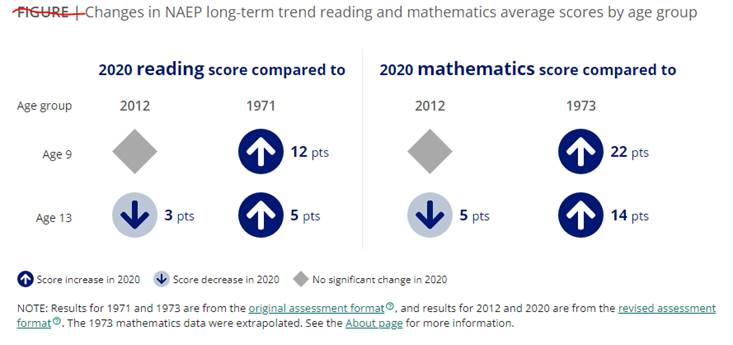
More About NAEP
To learn about upcoming NAEP assessments, download NAEP reports, and access sample questions, visit https://nces.ed.gov/nationsreportcard. Explore the latest NAEP results at https://nationsreportcard.gov.
Visit https://nces.ed.gov/nationsreportcard/about/covid19.aspx for more information about NAEP COVID-19 protocols.
Learn what NAEP means for schools that are selected to participate and get the latest NAEP news in Measure Up: NAEP News for the School Community, available online at https://nces.ed.gov/nationsreportcard/about/schools.aspx.
To hear teachers share their thoughts about why NAEP results are important, view the video Introducing NAEP to Teachers at https://nces.ed.gov/nationsreportcard/participating/schools.aspx.
To find your NAEP state coordinator’s contact information, visit https://nces.ed.gov/nationsreportcard/states and select your state or jurisdiction from the drop-down menu.
For additional assistance, call the NAEP help desk at 800-283-6237.
“The NAEP team that arrived at our school made the assessment process painless. Everyone on the team previously worked as an educator and interacted well with all of our students.”
—Kimberly Wilborn, Guidance Counselor, Sandburg Middle School, Fairfax County Public Schools, Alexandria, Virginia
National Center for Education Statistics (NCES) conducts the National Assessment of Educational Progress to evaluate federally supported education programs. All of the information you provide may be used only for statistical purposes and may not be disclosed, or used, in identifiable form for any other purpose except as required by law (20 U.S.C. §9573 and 6 U.S.C. §151). By law, every NCES employee as well as every NCES agent, such as contractors and NAEP coordinators, has taken an oath and is subject to a jail term of up to 5 years, a fine of $250,000, or both if he or she willfully discloses ANY identifiable information about you. Electronic submission of your information will be monitored for viruses, malware, and other threats by Federal employees and contractors in accordance with the Cybersecurity Enhancement Act of 2015.
This publication was prepared for the National Assessment of Educational Progress by Hager Sharp under contract GS-23F-0024M to the National Center for Education Statistics, U.S. Department of Education.
Appendix D4-7: NAEP 2022 Save the Date
NAEP Fall 2022 Save-the-Date Letter From
NAEP STATE COORDINATOR TO SCHOOL PRINCIPAL – For All Sampled Schools
Red text should be customized before mail merge; highlighted text represents mail merge fields
Save the date! NAEP is coming on assessment date.
Dear Principal:
In May, I notified you that school name was selected to participate in the 2022 administration of the National Assessment of Educational Progress (NAEP). This letter includes the scheduled assessment date for your school.
Thirteen-year-olds from your school will take the assessment on assessment date. Please place the NAEP assessment date on your 2022-2023 school calendar. Approximately estimated student sample students from your school will be selected to participate, but that number will vary depending on actual fall 2022 student enrollment numbers. The assessment will take about 90 minutes for most students, including transition time, directions, and completion of a survey questionnaire. NAEP representatives will provide significant support to your school, bring all necessary materials and equipment, and administer the assessment.
If you have questions or a conflict with the scheduled assessment date, please contact me at telephone number or email address by date. I will send you more information about preparing for the assessment at the beginning of the school year.
NAEP is a common measure of student achievement across the country and is used to inform education policies and practices. Schools and students have an important role in ensuring that NAEP results are accurate. Our goal is 100 percent participation in this important assessment, and we know that we can count on you to help us reach it.
Sincerely,
NAEP State Coordinator
CC: District Test Coordinator
National Center for Education Statistics (NCES) conducts the National Assessment of Educational Progress to evaluate federally supported education programs. All of the information you provide may be used only for statistical purposes and may not be disclosed, or used, in identifiable form for any other purpose except as required by law (20 U.S.C. §9573 and 6 U.S.C. §151). By law, every NCES employee as well as every NCES agent, such as contractors and NAEP coordinators, has taken an oath and is subject to a jail term of up to 5 years, a fine of $250,000, or both if he or she willfully discloses ANY identifiable information about you. Electronic submission of your information will be monitored for viruses, malware, and other threats by Federal employees and contractors in accordance with the Cybersecurity Enhancement Act of 2015.
Appendix D4-8: NAEP 2022 Parent/Guardian Notification Public Schools- English and Spanish
NAEP FALL 2022 PARENT/GUARDIAN NOTIFICATION LETTER PUBLIC SCHOOL
Long-Term Trend Age 13
(School Letterhead)
(Insert Date Here)
Dear Parent or Guardian:
(School name) will participate in the National Assessment of Educational Progress (NAEP) on (date). NAEP is the largest nationally representative and continuing assessment of what students know and can do in various subjects. NAEP is different from our state assessments because it is a common measure of achievement across the country. The assessment is administered by the National Center for Education Statistics, within the U.S. Department of Education. The results are released as The Nation’s Report Card, which provides information about student achievement to educators, parents, policymakers, and the public.
Your child (will/may) take a mathematics or reading assessment. In addition to subject-area questions, students voluntarily complete NAEP survey questions. These questions provide valuable information about participating students’ educational experiences and opportunities to learn both in and outside of the classroom. More information about NAEP survey questions is available at https://nces.ed.gov/nationsreportcard/parents under the section “What Questions Are on the Test?”
The assessment takes about 90 minutes for most students, which includes transition time, directions, and completion of survey questions.
The information collected is used for statistical purposes only.
Your child’s grades will not be affected.
Students may be excused for any reason, are not required to complete the assessment, and may skip any question.
While the assessment is voluntary, NAEP depends on student participation to help policymakers improve education. However, if you do not want your child to participate, please notify me in writing by (date).
There is no need to study in preparation for NAEP, but please encourage your child to do their best. Contact (name) at (telephone number) or at (email address) if you have any questions.
We are excited that our school is participating in NAEP. We know that (school name)’s students will show what our nation’s students know and can do.
Sincerely,
(School Principal’s Name)
National Center for Education Statistics (NCES) conducts the National Assessment of Educational Progress to evaluate federally supported education programs. All of the information you provide may be used only for statistical purposes and may not be disclosed, or used, in identifiable form for any other purpose except as required by law (20 U.S.C. §9573 and 6 U.S.C. §151). By law, every NCES employee as well as every NCES agent, such as contractors and NAEP coordinators, has taken an oath and is subject to a jail term of up to 5 years, a fine of $250,000, or both if he or she willfully discloses ANY identifiable information about you. Electronic submission of your information will be monitored for viruses, malware, and other threats by Federal employees and contractors in accordance with the Cybersecurity Enhancement Act of 2015.
CARTA DE NOTIFICACIÓN A LOS PADRES O TUTORES SOBRE NAEP DE OTOÑO 2022
ESCUELAS PÚBLICAS
TENDENCIA A LARGO PLAZO - 13 AÑOS DE EDAD
(Membrete de la escuela)
(Coloque la fecha aquí)
Estimado(a) padre, madre o tutor:
(Nombre de la escuela) participará en la Evaluación Nacional del Progreso Educativo (NAEP, por sus siglas en inglés) el (fecha). NAEP es la evaluación continua y nacionalmente representativa más grande acerca de lo que los estudiantes saben y pueden hacer en diferentes materias. NAEP es diferente de nuestras evaluaciones estatales ya que ofrece una medida común de los logros en todo el país. NAEP es administrada por el Centro Nacional de Estadísticas de la Educación (NCES, por sus siglas en inglés), parte del Departamento de Educación de Estados Unidos. Los resultados se publican en un informe llamado La Libreta de Calificaciones de la Nación, el cual les proporciona información a los educadores, padres, legisladores y al público acerca de los logros de los estudiantes.
Su hijo(a) (tomará/posiblemente tome) una evaluación de matemáticas o lectura. Además de las preguntas sobre la materia, los estudiantes contestan preguntas de contexto de NAEP de manera voluntaria. Las preguntas proporcionan información valiosa acerca de las experiencias y oportunidades de aprendizaje dentro y fuera del salón de clases de los estudiantes participantes. Puede encontrar más información acerca de las preguntas de NAEP en https://nces.ed.gov/nationsreportcard/parents/spanish.aspx en la sección “¿Qué se le preguntará a su hijo(a)?”
La evaluación toma unos 90 minutos para la mayoría de los estudiantes, incluyendo el tiempo de transición, instrucciones y el contestar las preguntas de contexto.
La información recolectada se utiliza únicamente con fines estadísticos.
Las calificaciones de su hijo(a) no se verán afectadas.
Los estudiantes pueden ser excusados por cualquier motivo, no están obligados a completar la evaluación y pueden dejar de responder cualquier pregunta.
Aunque la evaluación es voluntaria, NAEP depende de la participación de los estudiantes para ayudarles a los legisladores a mejorar la educación. No obstante, si no desea que su hijo(a) participe, por favor, notifíqueme por escrito antes de (fecha).
No es necesario estudiar en preparación para NAEP, pero anime a su hijo(a) a que haga su mejor esfuerzo. Si tiene alguna pregunta, comuníquese con (nombre) llamando al (número de teléfono) o por correo electrónico escribiendo a (correo electrónico).
Nos entusiasma que nuestra escuela participe en NAEP. Sabemos que los estudiantes de (nombre de la escuela) mostrarán lo que los estudiantes de nuestro país saben y pueden hacer.
Atentamente,
(Nombre del director(a) de la escuela)
El Centro Nacional para Estadísticas de la Educación (NCES, por sus siglas en inglés) administra la Evaluación Nacional del Progreso Educativo para evaluar programas de educación apoyados por el gobierno federal. Toda la información que proporciones podrá usarse únicamente con fines estadísticos y no podrá darse a conocer o usarse ni para identificarte ni para cualquier otro propósito salvo aquel requerido legalmente (20 U.S.C. §9573 y 6 U.S.C. §151). Por ley, todos los empleados de NCES al igual que todos los representantes del mismo, como contratistas y coordinadores de NAEP, han hecho un juramento y están sujetos a una pena de prisión de hasta 5 años, una multa de hasta $250,000 o ambas cosas, si dan a conocer intencionalmente CUALQUIER información que te identifique. El envío de tu información por vía electrónica será monitoreado por empleados y contratistas federales para detectar virus, programas maliciosos (malware) y otras amenazas conforme a la Ley de Mejoramiento de la Seguridad Cibernética de 2015.
Appendix D4-9: NAEP 2022 Parent/Guardian Notification Private Schools- English and Spanish
NAEP FALL 2022 PARENT/GUARDIAN NOTIFICATION LETTER PRIVATE SCHOOL
Long-Term Trend Age 13
(School Letterhead)
(Insert Date Here)
Dear Parent or Guardian:
We are pleased to notify you that (school name) has been selected to represent private schools across the nation by participating in the National Assessment of Educational Progress (NAEP) on (date). NAEP is the largest nationally representative and continuing assessment of what students in public and private schools know and can do in various subjects, and is different from state and school assessments because it provides a common measure of student achievement across the country. It is administered by the National Center for Education Statistics, within the U.S. Department of Education. The results are released as The Nation’s Report Card, which provides information about student achievement to educators, parents, policymakers, and the public.
Your child (will/may) take a mathematics or reading assessment. In addition to subject-area questions, students voluntarily complete a NAEP survey questionnaire. The questionnaire provides valuable information about participating students’ educational experiences and opportunities to learn both in and outside of the classroom. More information is available at https://nces.ed.gov/nationsreportcard/parents under the section “What Questions Are on the Test?”
The assessment takes approximately 90 minutes for most students, including transition time, directions, and completion of the survey questions.
The information collected is used for statistical purposes only.
Your child’s grades will not be affected.
Students may be excused for any reason, are not required to complete the assessment, and may skip any question.
While the assessment is voluntary, NAEP depends on student participation to help policymakers improve education. However, if you do not want your child to participate, please notify me in writing by (date).
There is no need to study in preparation for NAEP, but please encourage your child to do their best. Contact (name) at (telephone number) or at (email address) if you have any questions. To learn more about private school participation in NAEP, visit https://nces.ed.gov/nationsreportcard/participating/private_nonpublic.aspx.
We are excited that our school is participating in NAEP. We know that (school name)’s students will show what our nation’s students in private schools know and can do.
Sincerely,
School Principal
National Center for Education Statistics (NCES) conducts the National Assessment of Educational Progress to evaluate federally supported education programs. All of the information you provide may be used only for statistical purposes and may not be disclosed, or used, in identifiable form for any other purpose except as required by law (20 U.S.C. §9573 and 6 U.S.C. §151). By law, every NCES employee as well as every NCES agent, such as contractors and NAEP coordinators, has taken an oath and is subject to a jail term of up to 5 years, a fine of $250,000, or both if he or she willfully discloses ANY identifiable information about you. Electronic submission of your information will be monitored for viruses, malware, and other threats by Federal employees and contractors in accordance with the Cybersecurity Enhancement Act of 2015.
CARTA DE NOTIFICACIÓN A LOS PADRES O TUTORES SOBRE NAEP DE OTOÑO 2022
ESCUELAS PRIVADAS
Tendencia a Largo Plazo - 13 años de edad
(Membrete de la escuela)
(Coloque la fecha aquí)
Estimado(a) padre, madre o tutor:
Nos complace notificarle que (nombre de la escuela) ha sido seleccionada para representar a las escuelas privadas de todo el país al participar en la Evaluación Nacional del Progreso Educativo (NAEP, por sus siglas en inglés) el (fecha). NAEP es la evaluación continua y nacionalmente representativa más grande acerca de lo que los estudiantes en las escuelas privadas saben y pueden hacer en diferentes materias y es diferente de las evaluaciones estatales y escolares ya que ofrece una medida común de los logros de los estudiantes en todo el país. NAEP es administrada por el Centro Nacional de Estadísticas de la Educación (NCES, por sus siglas en inglés), parte del Departamento de Educación de Estados Unidos. Los resultados se publican en un informe llamado La Libreta de Calificaciones de la Nación, el cual les proporciona información a los educadores, padres, legisladores y al público acerca de los logros de los estudiantes.
Su hijo(a) (tomará/posiblemente tome) una evaluación de matemáticas o lectura. Además de las preguntas sobre la materia, los estudiantes contestan cuestionarios de contexto de NAEP de manera voluntaria. Los cuestionarios proporcionan información valiosa acerca de las experiencias y oportunidades de aprendizaje dentro y fuera del salón de clases de los estudiantes participantes. Puede encontrar más información acerca de las preguntas de NAEP en https://nces.ed.gov/nationsreportcard/parents/spanish.aspx en la sección “¿Qué se le preguntará a su hijo(a)?”
La evaluación toma aproximadamente 90 minutos para la mayoría de los estudiantes, incluyendo el tiempo de transición, instrucciones y el contestar las preguntas de contexto.
La información recolectada se utiliza únicamente con fines estadísticos.
Las calificaciones de su hijo(a) no se verán afectadas.
Los estudiantes pueden ser excusados por cualquier motivo, no están obligados a completar la evaluación y pueden dejar de responder cualquier pregunta.
Aunque la evaluación es voluntaria, NAEP depende de la participación de los estudiantes para ayudarles a los legisladores a mejorar la educación. No obstante, si no desea que su hijo(a) participe, por favor, notifíqueme por escrito antes de (fecha).
No es necesario estudiar en preparación para NAEP, pero anime a su hijo(a) a que haga su mejor esfuerzo. Si tiene alguna pregunta, comuníquese con (nombre) llamando al (número de teléfono) o por correo electrónico escribiendo a (correo electrónico). Para saber más sobre la participación de las escuelas privadas en la NAEP, visite https://nces.ed.gov/nationsreportcard/participating/private_nonpublic.aspx (en inglés).
Nos entusiasma que nuestra escuela participe en NAEP. Sabemos que los estudiantes de (nombre de la escuela) mostrarán lo que los estudiantes en las escuelas privadas de nuestro país saben y pueden hacer.
Atentamente,
Director(a) de la escuela
El Centro Nacional para Estadísticas de la Educación (NCES, por sus siglas en inglés) administra la Evaluación Nacional del Progreso Educativo para evaluar programas de educación apoyados por el gobierno federal. Toda la información que proporciones podrá usarse únicamente con fines estadísticos y no podrá darse a conocer o usarse ni para identificarte ni para cualquier otro propósito salvo aquel requerido legalmente (20 U.S.C. §9573 y 6 U.S.C. §151). Por ley, todos los empleados de NCES al igual que todos los representantes del mismo, como contratistas y coordinadores de NAEP, han hecho un juramento y están sujetos a una pena de prisión de hasta 5 años, una multa de hasta $250,000 o ambas cosas, si dan a conocer intencionalmente CUALQUIER información que te identifique. El envío de tu información por vía electrónica será monitoreado por empleados y contratistas federales para detectar virus, programas maliciosos (malware) y otras amenazas conforme a la Ley de Mejoramiento de la Seguridad Cibernética de 2015.
Appendix D4-10: NAEP 2022 School Coordinator Responsibilities, A Guide to MyNAEP, LTT, Public Schools
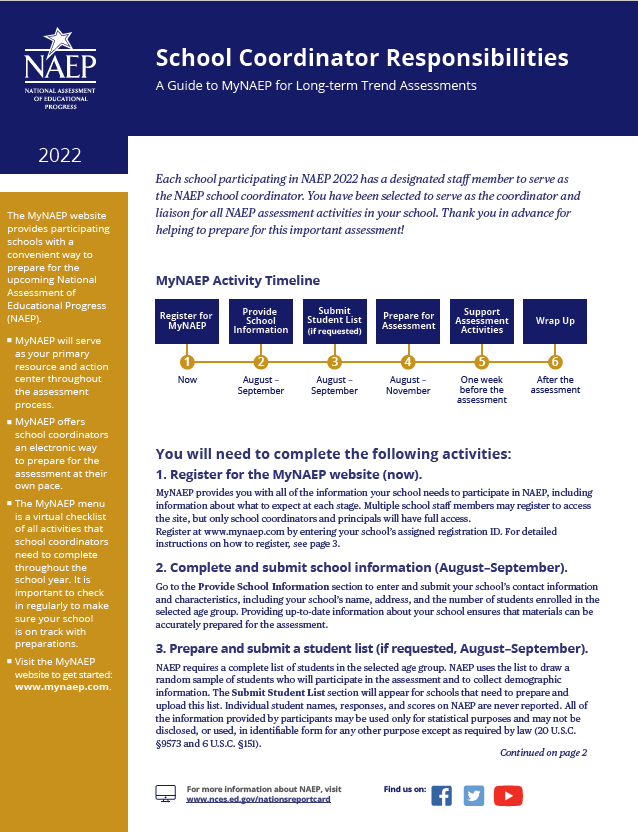
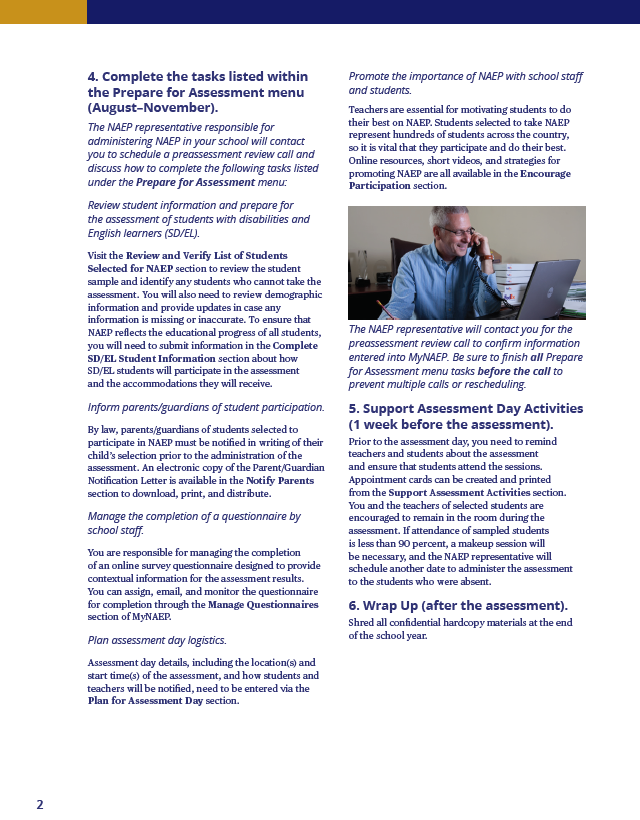
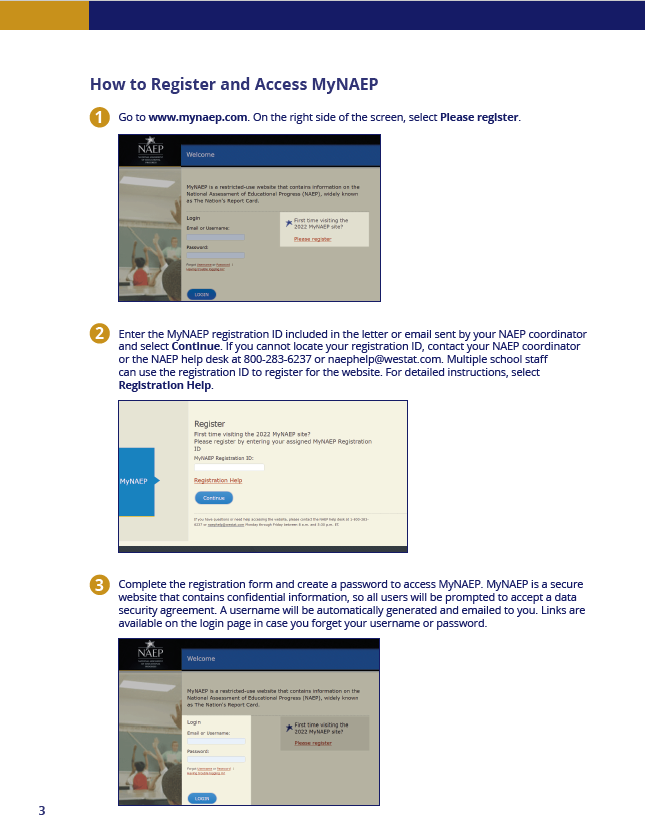
Appendix D4-11: NAEP 2022 School Coordinator Responsibilities, A Guide to MyNAEP, LTT, Private Schools

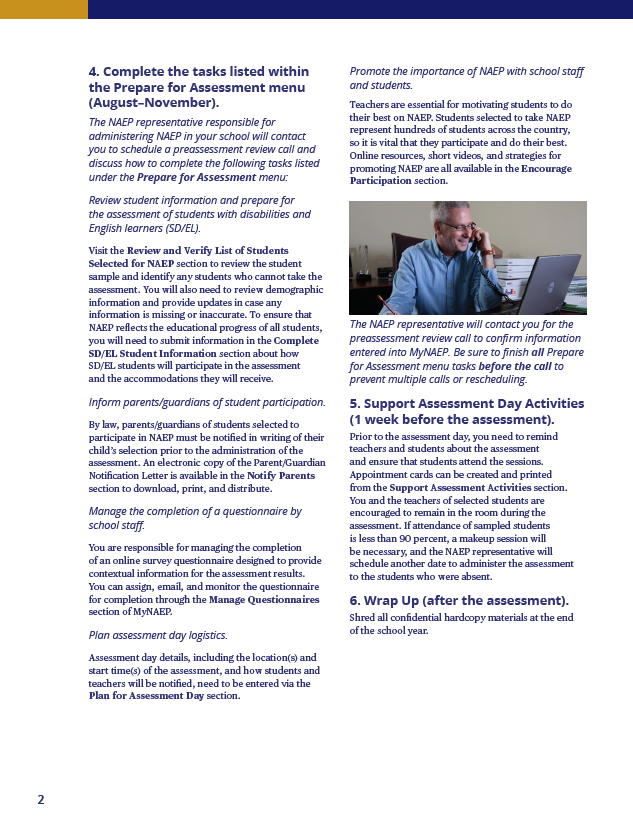
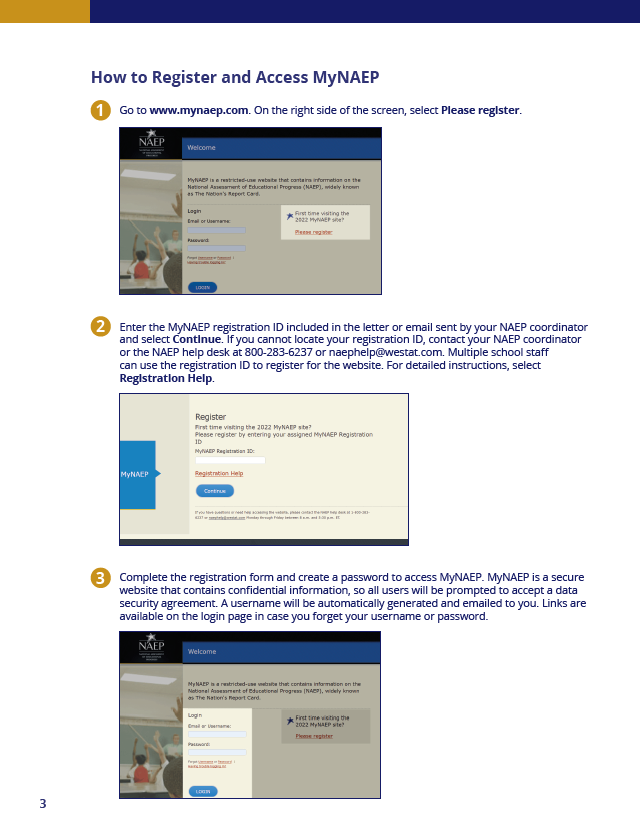
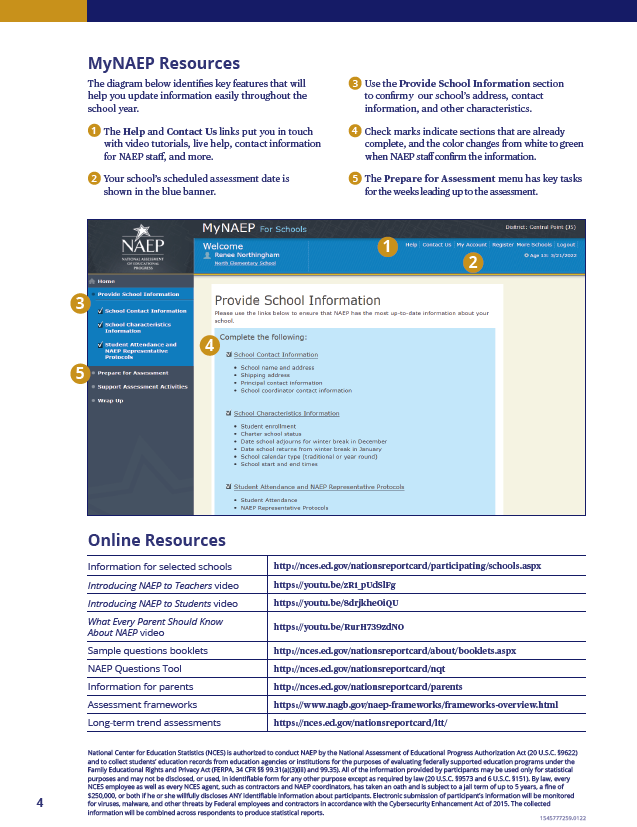
Appendix D4-12: NAEP 2022 NAEP in Your School, LTT, Public Schools and Private Schools
NAEP in Your School: Fall 2022
Age 13 Long-Term Trend Mathematics and Reading
“NAEP is the only assessment providing half a century of performance data to measure what students know and can do. The state and national trends inform local, state, and national program and policy discussions that improve teaching and learning.”
– David Atherton, EdD, Principal, Clear Creek Middle School, Gresham, OR
What is NAEP?
The National Assessment of Educational Progress (NAEP) is an integral measure of academic progress across the nation and over time. It is the largest nationally representative and continuing assessment of what our nation’s students know and can do in various subjects such as civics, mathematics, reading, and U.S. history. The program also provides valuable insights into students’ educational experiences and opportunities to learn in and outside of the classroom.
NAEP is a congressionally mandated program administered by the National Center for Education Statistics (NCES), within the U.S. Department of Education and the Institute of Education Sciences.
How are NAEP results reported?
The results of NAEP are released as The Nation’s Report Card. Depending on the assessment, NAEP results are available for the nation, states, and select urban districts that participate in the Trial Urban District Assessment (TUDA). Results are also available for different student groups, based on factors such as race/ethnicity, gender, school location, and more. NAEP is not designed to collect or report results for individual students, classrooms, or schools.
Why should my school participate in NAEP?
Your school’s participation will help ensure that you and your fellow educators—as well as policymakers and elected officials—have reliable data to better understand and improve student learning.
Your school and students represent schools and students across the country. When students participate and give their best effort, NAEP results provide the most accurate and representative measure possible of student achievement and experience.
What NAEP assessments will be administered in fall 2022?
The NAEP long-term trend assessment will be administered via paper and pencil to 13-year-olds in your school between October 10 and December 16, 2022. NAEP long-term trend assessments measure student performance in mathematics and reading, and allow the performance of today’s students to be compared with students since the early 1970s. Students will also be asked to complete a survey questionnaire to provide a better understanding of factors that may be related to students’ learning. There will be no teacher questionnaire, but a school questionnaire will be administered.
Results will be released for the nation.
What will my students do?
Participating 13-year-olds will complete subject-area questions in mathematics or reading. Each student will be assessed in one subject only. Students will also complete a survey questionnaire that provides valuable information about their educational experiences and opportunities to learn both in and outside of the classroom, as well as how they have accessed learning during the COVID-19 pandemic.
It takes approximately 90 minutes for students to complete the paper-based assessment, including transition time, directions, and completion of survey questionnaires. A broad range of accommodations are provided for students with disabilities and English learners.
Do teachers need to prepare students for the assessment?
Teachers do not need to prepare their students to take the assessment but should encourage them to do their best.
How can my teachers and I use NAEP data to help our students?
The NAEP Data Explorer (https://www.nationsreportcard.gov/ndecore) is a powerful tool that allows you to examine the relationships between student performance and factors such as instructional practices, school resources, and more.
Questions from previous NAEP assessments can also be used as a helpful educational resource in the classroom. Teachers can use the NAEP Questions Tool (http://nces.ed.gov/nationsreportcard/nqt) to see how their students’ performance compares to peers in your state and across the nation. Released NAEP questions come with a scoring guide, sample student responses, and performance data.
Who will administer NAEP in my school? What does my school need to provide on the day of the assessment?
NAEP representatives will administer the NAEP assessment and provide significant support to your school on assessment day. They will wear necessary personal protective equipment (PPE) and follow all school-specific health protocols. NAEP representatives will also bring all necessary materials and equipment. Schools will only need to provide space for students to take the assessment.
More information about roles and responsibilities for coordinating and administering NAEP in your school are on the last page of this fact sheet.
How was my school selected for NAEP?
Your school was selected as part of a carefully designed sampling process that ensures NAEP-selected schools and students are representative of their district, state, and the nation.
How is NAEP different from our state assessment?
NAEP serves a different role than state assessments. While states have their own unique assessments to measure student achievement against specific content standards, NAEP is designed to provide a common measure of student performance and progress across the country.
How long has NAEP been around?
NAEP was first administered in 1969 to measure student achievement nationally. In 1990, NAEP was administered at the state level for the first time. The NAEP TUDA program, which measures student achievement in some of the nation’s large urban districts, began in 2002. The program has come to be recognized as the gold standard of large-scale assessments due to its high technical quality and rigorous design and methodology.
How often is NAEP administered?
Students in grades 4 and 8 are scheduled to be assessed at the state and national levels in mathematics and reading every 2 years. Under the Elementary and Secondary Education Act, districts and states that receive Title I funds are required to participate in these biennial assessments. Other subjects are assessed periodically. Long-term trend assessments for 9-, 13-, and 17-year-olds are also assessed periodically.
Where can I find more information?
Learn more about the NAEP program at nces.ed.gov/nationsreportcard, and explore the latest NAEP results at nationsreportcard.gov.
Visit https://nces.ed.gov/nationsreportcard/about/covid19.aspx for more information about NAEP COVID-19 protocols.
You can also find NAEP on: <Facebook logo> <Twitter logo> <YouTube logo>
Roles and Responsibilities for Coordinating and Administering NAEP
Your NAEP State Coordinator, NAEP representatives, and school staff will work together to coordinate and administer the assessment. You will need to assign a staff member from your school to serve as the school coordinator and work closely with NAEP representatives to organize assessment activities. This person will be the primary contact for the assessment and should be familiar with how students participate in statewide assessments and how to use a computer to collect and enter student information online.
The school coordinator will be responsible for
confirming the scheduled assessment date with the NAEP State Coordinator;
registering for the MyNAEP website and providing information about the school;
if requested, overseeing the submission of an electronic list of 13-year-olds;
using the MyNAEP website to prepare for the assessment;
notifying parents of the assessment (more information will be provided on how to complete this task);
communicating with NAEP representatives and participating in a preassessment review call to finalize assessment preparations;
reserving space for the assessment, including room(s) and desks or tables; and
collaborating with school staff to ensure a high rate of student participation.
Additional information about the school coordinator’s responsibilities will be sent prior to NAEP representatives contacting you.
The NAEP State Coordinator works at your state department of education and will be responsible for
working with schools to confirm the assessment date;
communicating with principals about the importance of NAEP and student participation;
providing schools with instructions for preparing a list of students and information about notifying parents of participating students;
providing guidance for including students with disabilities and English learners; and
responding to questions from the school community throughout the assessment period.
NAEP representatives, employed by a U.S. Department of Education contractor to work directly with schools, will be responsible for
selecting a random sample of 13-year-olds from the school list;
verifying information that the school coordinator has provided via the MyNAEP website, the online hub for completing school preparation activities throughout the NAEP assessment process;
working with the school coordinator to finalize assessment logistics;
bringing all assessment materials to the school on the scheduled day; and
administering the assessment.
Each principal will be responsible for
assigning a school staff member to serve as the school coordinator;
including the NAEP assessment date on the school calendar;
empowering the designated school coordinator to work with NAEP representatives to prepare for the assessment; and
informing school staff and students about NAEP and why student participation is critically important.
National Center for Education Statistics (NCES) conducts the National Assessment of Educational Progress to evaluate federally supported education programs. All of the information you provide may be used only for statistical purposes and may not be disclosed, or used, in identifiable form for any other purpose except as required by law (20 U.S.C. §9573 and 6 U.S.C. §151). By law, every NCES employee as well as every NCES agent, such as contractors and NAEP coordinators, has taken an oath and is subject to a jail term of up to 5 years, a fine of $250,000, or both if he or she willfully discloses ANY identifiable information about you. Electronic submission of your information will be monitored for viruses, malware, and other threats by Federal employees and contractors in accordance with the Cybersecurity Enhancement Act of 2015.
.
This publication was prepared for the National Assessment of Educational Progress by Hager Sharp under contract GS-23F-0024M to the National Center for Education Statistics, U.S. Department of Education.
NAEP in Your Private School Fall 2022
Age 13 Long-Term Trend Mathematics and Reading
Page 1 Sidebar:
What is NAEP?
The National Assessment of Educational Progress (NAEP) is an essential measurement of student achievement in the United States.
First administered in 1969, NAEP is the largest continuing and nationally representative assessment of what our nation’s public and private school students know and can do in various subjects.
The schools and students participating in NAEP make an important contribution by representing other schools and students across the country.
NAEP is a common measure of academic progress across the nation and over time. The results are released as The Nation’s Report Card.
Page 1 Text:
Why participate in NAEP?
Participation in NAEP gives private schools a voice in the national conversation about education. Your school has been selected to represent other private schools across the nation, and it is vital that all selected students participate to accurately capture our students’ progress.
Schools, students, and teachers who participate in NAEP enable The Nation’s Report Card to provide more inclusive representation of what our nation’s students know and can do in key subject areas. NAEP has consistently demonstrated over time and across subjects that students in private schools on average outperform students in public schools.
NAEP long-term trend assessments measure student performance in mathematics and reading, and allow the performance of today’s students to be compared with students since the early 1970s.
How will NAEP 2022 be administered in your school?
From October 10 to December 16, 2022, NAEP will be administered in public and private schools across the country. NAEP representatives will administer the NAEP assessment to selected 13-year-old students and provide significant support to your school on assessment day. They will wear necessary personal protective equipment (PPE) and follow all school-specific health protocols. NAEP representatives will also bring all necessary materials. Schools will only need to provide space for students to take the assessment.
Visit https://nces.ed.gov/nationsreportcard/about/covid19.aspx for more information about NAEP COVID-19 protocols.
[The following three questions and answers each appear inside their own word-bubble graphic]
What subjects will students be assessed in?
One subject per student
Math or reading
How will the assessment be conducted?
Administered by NAEP personnel (in PPE)
As paper-and-pencil assessment
How long will the assessment take?
About 90 minutes including
Transition, directions, and questionnaires
Students will also complete survey questionnaires that provide valuable information about their educational experiences and opportunities to learn both in and outside of the classroom, as well as how they have accessed learning during the COVID-19 pandemic. In addition to the student questionnaire, the school principal will also be asked to complete a questionnaire. This questionnaire covers topics such as teacher training and school policies to provide valuable information for education stakeholders who need to gain a better picture of student performance.
[Large quote at top of page 2]
“The Council for American Private Education (CAPE) strongly encourages private schools to participate in NAEP, an essential measure of student achievement in the United States.”
Michael Schuttloffel
Executive Director, CAPE
Page 2 Text:
What are the responsibilities of the principal and school coordinator?
The principal is responsible for
Including the NAEP assessment date on the school calendar;
Designating a school coordinator to work with NAEP representatives and to prepare for the assessment;
Informing school staff about NAEP and why participation is critically important; and
Completing the school questionnaire.
The school coordinator is responsible for
Confirming that the suggested assessment date works with the school calendar;
Securing space for the assessment to take place;
Providing a list of eligible students from which a random sample will be selected for participation in the assessment (student and school names will not be included in any reports)*;
Informing parents about the assessment;
Completing preassessment activities with guidance and support from NAEP representatives; and
Ensuring that students attend the session on the assessment date.
NAEP representatives will take care of everything else related to preparing for and conducting the assessment.
For more information about NAEP visit:
Program overview http://nces.ed.gov/nationsreportcard
Private school participation https://nces.ed.gov/nationsreportcard/participating/private_nonpublic.aspx
NAEP – Giving Private Schools a Voice in the National Conversation
Find us on:
[Facebook, Twitter, and YouTube logos]
(Located across from “Find us on:” section or as footer on Page 1):
* National Center for Education Statistics (NCES) conducts the National Assessment of Educational Progress to evaluate federally supported education programs. All of the information you provide may be used only for statistical purposes and may not be disclosed, or used, in identifiable form for any other purpose except as required by law (20 U.S.C. §9573 and 6 U.S.C. §151). By law, every NCES employee as well as every NCES agent, such as contractors and NAEP coordinators, has taken an oath and is subject to a jail term of up to 5 years, a fine of $250,000, or both if he or she willfully discloses ANY identifiable information about you. Electronic submission of your information will be monitored for viruses, malware, and other threats by Federal employees and contractors in accordance with the Cybersecurity Enhancement Act of 2015.
Appendix D4-13: NAEP 2022 LTT Age 13 Sample Endorsement Letters
NAEP 2022 Long-Term Trend Age 13 Sample Endorsement Letter
From Council for American Private Education (CAPE) to Private School Administrator
Red text should be customized and letter should be finalized on CAPE letterhead
Spring 2022
Dear Administrator:
As we prepare to begin another school year, the COVID-19 pandemic continues to pose significant challenges for schools, students, families, and staff. The Council for American Private Education’s (CAPE) thoughts are with you. I commend you for the extraordinary efforts you and your staff have expended to meet these challenges and address the needs of your entire school community during these last few years. With challenge comes opportunity, and today I am writing to encourage you to participate in the 2022 National Assessment of Educational Progress (NAEP). Your school’s participation helps ensure that the true diversity of our nation’s schools are reflected in NAEP’s results and the performance of private school students can be reported.
CAPE considers NAEP an essential measure of student achievement in the United States. First administered in 1969, NAEP is the largest continuing and nationally representative measure of private and public school student achievement across the country. Your school’s participation will help make it possible for private school data to be reported and contribute to the picture of education across the nation and to future policy decisions. NAEP data have consistently shown, across subjects and over time, that students in private schools on average score higher than students in public schools.
Private schools account for about 24 percent of all schools in the nation and educate approximately 9 percent of all school children across the country. Therefore, it is important that our students' performance be included in all data that describe the condition of education in the United States. With your support, private schools can achieve excellent participation, and private school results can be reported.
For the benefit of the private school community and to provide the most accurate information about student achievement in the United States, I strongly urge you to participate.
If you have questions or concerns about participating in NAEP, please contact [private school organization contact person and contact information] OR Mary Erbe at 502-459-0478 or [email protected].
Sincerely,
[Name]
Council for American Private Education
Title
NAEP 2022 Long-Term Trend Age 13 Sample Endorsement Letter
From Private School Organization to Non-Religious Private School Administrator
Red text should be customized and letter should be finalized on organization letterhead
Spring 2022
Dear Administrator:
As we prepare to begin another school year, the COVID-19 pandemic continues to pose significant challenges for schools, students, families, and staff. My thoughts are with you. I commend you for the extraordinary efforts you and your staff have expended to meet these challenges and address the needs of your entire school community during these last few years. With challenge comes opportunity, and today I am writing to encourage you to participate in the 2022 National Assessment of Educational Progress (NAEP).
First administered in 1969, NAEP is the largest continuing and nationally representative measure of private and public school student achievement across the country. Following years in which many schools provided primarily remote and/or hybrid instruction, nationally representative data on student achievement is especially valuable and important. NAEP data have consistently shown, across subjects and over time, that students in private schools on average score higher than students in public schools. Your school’s participation is an opportunity to help make it possible for private school data to be reported and compared with that of public schools. These data will contribute to the picture of education across the nation and to future policy decisions.
For the benefit of the private school community and to provide the most accurate information about student achievement in the United States, I strongly urge you to participate.
If you have questions about participating in NAEP, please contact [private school organization contact person and contact information] OR Mary Erbe at 502-459-0478 or [email protected].
Sincerely,
[Name]
Private School Organization
Title
NAEP 2022 Long-Term Trend Age 13 Sample Endorsement Letter
From Private School Organization to Religious Private School Administrator
Red text should be customized and letter should be finalized on organization letterhead
Spring 2022
Dear Administrator:
As we prepare to begin another school year, the COVID-19 pandemic continues to pose significant challenges for schools, students, families, and staff. My thoughts are with you. I commend you for the extraordinary efforts you and your staff have expended to meet these challenges and address the needs of your entire school community during these last few years. With challenge comes opportunity, and today I am writing to encourage you to participate in the 2022 National Assessment of Educational Progress (NAEP).
First administered in 1969, NAEP is the largest continuing and nationally representative measure of private and public school student achievement across the country. Following years in which many schools provided primarily remote and/or hybrid instruction, nationally representative data on student achievement is especially valuable and important. NAEP data have consistently shown, across subjects and over time, that students in private schools on average score higher than students in public schools. Your school’s participation is an opportunity to help make it possible for private school data to be reported and compared with that of public schools. These data will contribute to the picture of education across the nation and to future policy decisions.
For the benefit of the private school community and to provide the most accurate information about student achievement in the United States, I strongly urge you to participate. Participation in NAEP can become one of your building blocks for motivating students to contribute to the greater good as they model productive and faith-based lives.
If you have questions about participating in NAEP, please contact [private school organization contact person and contact information] OR Mary Erbe at 502-459-0478 or [email protected].
Sincerely,
[Name]
Private School Organization
Title
Appendix D4-14: NAEP 2022 LTT Age 13 MyNAEP Registration Instructions for Schools
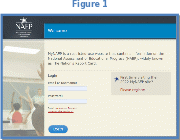
Go to https://www.mynaep.com and select the Please register link on the right.
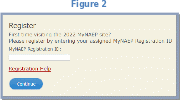
Enter the registration ID for school name (XXXXXXXX) and select Continue.
Figure
3

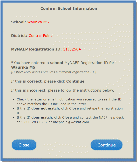
A confirmation window will appear to ensure that you are registering for the correct school.
Select Continue if the information is correct.
If the information is incorrect, follow the instructions in the window and select Cancel.
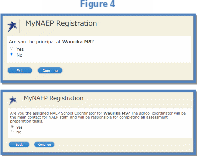
Indicate whether you are the principal or the school coordinator (or both).
Principals and school coordinators are the only school personnel with full access.
The registration form will appear. Enter your name, phone number, and email address (see Figure 5).
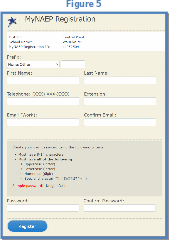
Create your own password using the following criteria (see Figure 5).
Must have 8–14 characters
Needs at least one of each:
uppercase letter
lowercase letter
numerical digit
special character
(*!,~%@#$%?^+=& )
Sample password: KnightsR#1
Make sure to remember your password – write it down if necessary.
Select Register (see Figure 5).
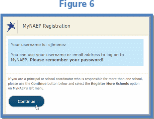
Write down your assigned username. You will need your username or email and password to access MyNAEP throughout the year.
Select Continue.

All school personnel who register for MyNAEP must accept a confidentiality agreement. Please review and accept the agreement to access the site.

Select Provide School Information from the left-hand menu.
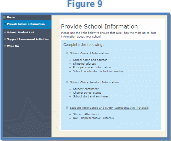
Use the links to confirm or enter the following information. Please complete this section one time. Your NAEP Coordinator will be alerted each time you make a change, and they have to review and approve every entry.
School Contact Information
School name and address
Shipping address
Principal (name, email, phone)
School coordinator (name, email, phone)
School Characteristics
Age-13 student enrollment
Is your school a charter school? Yes/No
School start and end times for scheduled assessment date
Date school adjourns in December for winter break
Date school returns from winter break in January
Student Attendance and Schedules
What days of the week do age-13 students attend school in your school building?
How many enrolled age-13 students currently attend school full time remotely/virtually?
How many enrolled age-13 students currently attend school in person (full time or at least one day a week) in your school building?
Do any state/district policies require a negative COVID-19 test or vaccination for NAEP representatives?
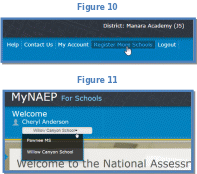
Special situations:
If you are a principal or school coordinator who is responsible for more than one school, select Register More Schools from MyNAEP's upper right-hand menu and enter the additional registration ID(s), one at a time. Afterwards, you can access all of your assigned schools with a drop-down menu (see Figures 10 and 11).
| File Type | application/vnd.openxmlformats-officedocument.wordprocessingml.document |
| Author | Molin, Ed C |
| File Modified | 0000-00-00 |
| File Created | 2022-03-03 |
© 2025 OMB.report | Privacy Policy
